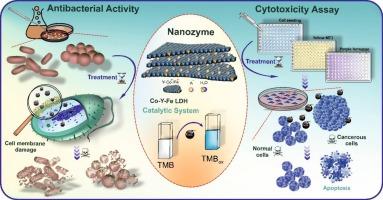Synthesis and multifaceted characterization of bioactive Co-Y-Fe layered double hydroxide: bridging peroxidase-mimic function with antibacterial and anticancer efficacy in a unified strategy
IF 5.8
2区 地球科学
Q2 CHEMISTRY, PHYSICAL
引用次数: 0
Abstract
Increasing antibiotic-resistant infections and rapidly progressing cancers have led to a serious demand for more effective platforms to overcome the challenges related to conventional therapies. The catalytic reaction between nanozymes and hydrogen peroxide (H2O2) generates reactive oxygen species (ROSs), which effectively break down bacterial cell walls and induce apoptosis in cancer cells without causing significant off-target effects. Accordingly, nanozymes have emerged as promising nanostructures for biomedical and antibacterial applications. Herein, a novel cobalt(II)‑yttrium(III)‑iron(III) layered double hydroxide (Co-Y-Fe LDH) was synthesized and characterized in terms of structure, composition, and surface properties. After investigating the enzyme-mimic performance, the peroxidase-based antibacterial efficiency was extensively evaluated against Escherichia coli (E. coli) and Staphylococcus aureus (S. aureus), showing a minimum inhibitory concentration (MIC) of Co-Y-Fe LDH to be 38.7 ± 0.53 μg mL−1 and 33.1 ± 0.41 μg mL−1, respectively. Furthermore, the cytotoxic evaluations exhibited potent anticancer activity against cancer cells with a half-maximal inhibitory concentration (IC50) of 25.01 ± 1.2 μg mL−1. Meanwhile, the case-studied nanozyme exhibited insignificant toxicity towards the human normal cells. These results indicate the multifunctional capabilities of Co-Y-Fe LDH as an effective antibacterial and anticancer agent with a biocompatible nature for a wide range of applications.

生物活性Co-Y-Fe层状双氢氧化物的合成和多方面表征:具有抗菌和抗癌功效的桥接过氧化物酶模拟功能
越来越多的抗生素耐药感染和迅速发展的癌症导致对更有效的平台的严重需求,以克服与传统疗法相关的挑战。纳米酶与过氧化氢(H2O2)的催化反应产生活性氧(ROSs),可以有效地破坏细菌细胞壁,诱导癌细胞凋亡,而不会产生明显的脱靶效应。因此,纳米酶已成为生物医学和抗菌应用的有前途的纳米结构。本文合成了一种新型的钴(II) -钇(III) -铁(III)层状双氢氧化物(Co-Y-Fe LDH),并对其结构、组成和表面性能进行了表征。通过对酶模拟性能的研究,广泛评价了过氧化物酶对大肠杆菌(E. coli)和金黄色葡萄球菌(S. aureus)的抑菌效果,结果表明Co-Y-Fe LDH的最低抑菌浓度(MIC)分别为38.7±0.53 μg mL - 1和33.1±0.41 μg mL - 1。此外,细胞毒性评价显示出强大的抗癌活性,半最大抑制浓度(IC50)为25.01±1.2 μ mL−1。同时,所研究的纳米酶对人体正常细胞的毒性不明显。这些结果表明,Co-Y-Fe LDH作为一种具有生物相容性的有效抗菌和抗癌剂具有广泛的应用前景。
本文章由计算机程序翻译,如有差异,请以英文原文为准。
求助全文
约1分钟内获得全文
求助全文
来源期刊

Applied Clay Science
地学-矿物学
CiteScore
10.30
自引率
10.70%
发文量
289
审稿时长
39 days
期刊介绍:
Applied Clay Science aims to be an international journal attracting high quality scientific papers on clays and clay minerals, including research papers, reviews, and technical notes. The journal covers typical subjects of Fundamental and Applied Clay Science such as:
• Synthesis and purification
• Structural, crystallographic and mineralogical properties of clays and clay minerals
• Thermal properties of clays and clay minerals
• Physico-chemical properties including i) surface and interface properties; ii) thermodynamic properties; iii) mechanical properties
• Interaction with water, with polar and apolar molecules
• Colloidal properties and rheology
• Adsorption, Intercalation, Ionic exchange
• Genesis and deposits of clay minerals
• Geology and geochemistry of clays
• Modification of clays and clay minerals properties by thermal and physical treatments
• Modification by chemical treatments with organic and inorganic molecules(organoclays, pillared clays)
• Modification by biological microorganisms. etc...
 求助内容:
求助内容: 应助结果提醒方式:
应助结果提醒方式:


